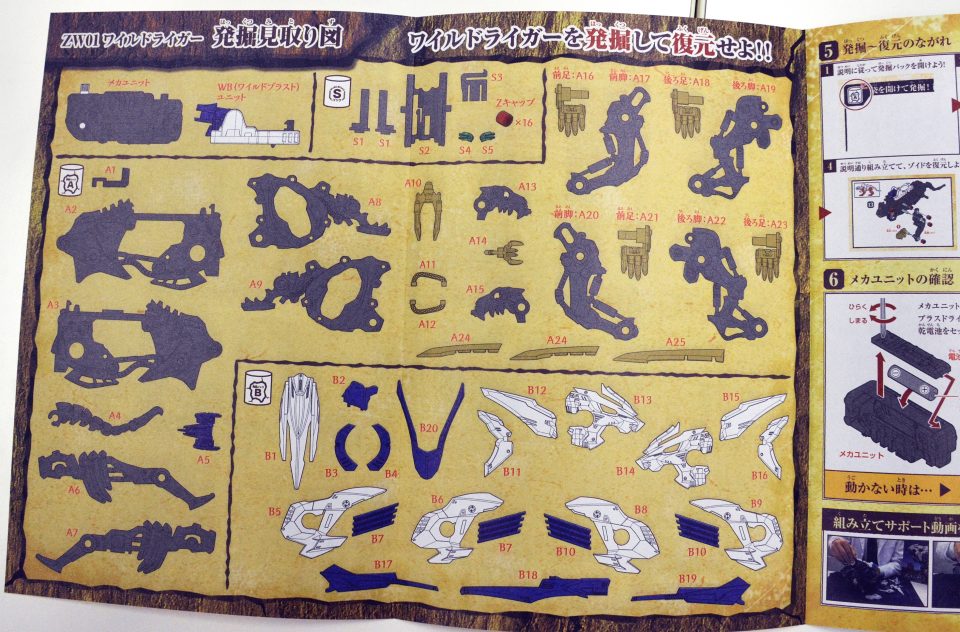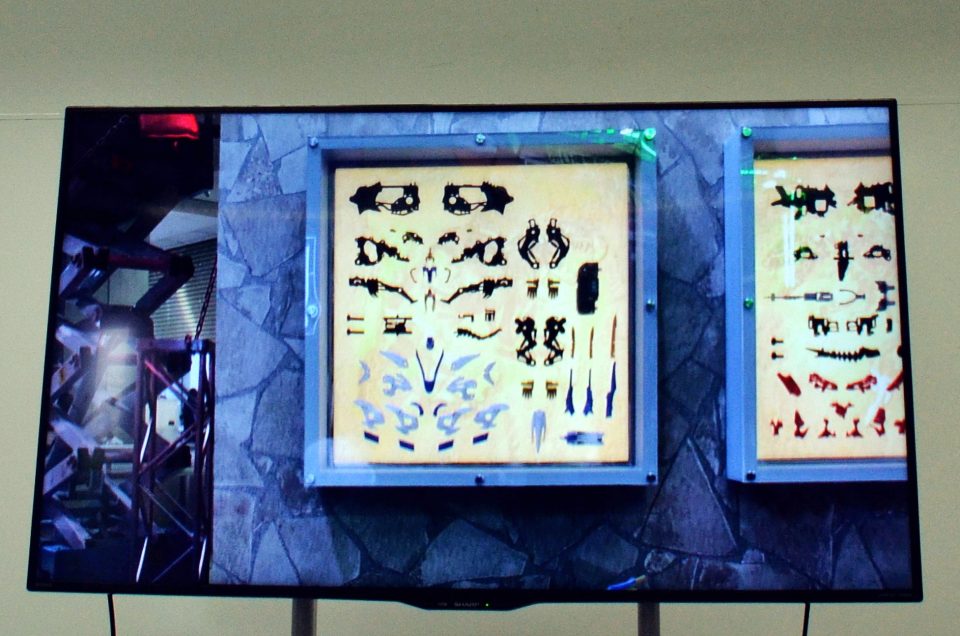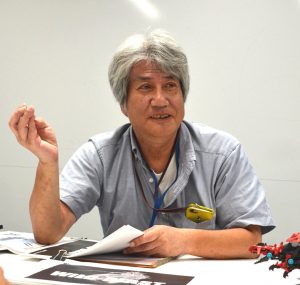
- CoroCoro Interview with Tokuyama!
Tokuyama, the creator of Zoids, and 56,560,000 Characters!?
NOTE: This article was translated using google translate, so please be aware that there are bound to be mistakes! It is only presented as a slightly more coherent-to-read alternative to automatic translation.
The Exceedingly Long Interview: Part 4
The Secret Story of Zoids Wild's Development, Part 4!
The Zoids World opens up the moment you open the box!
A reboot with a new world view for a new generation!
A reboot with a new world view for a new generation!
This is our fourth interview with Mitsutoshi Tokuyama, the legend behind Zoids both old and new! In the previous interview, we established that Wild Liger was the result of the combined efforts of successive members of the Zoids staff. This time, Mr. Tokuyama will be talking about his thoughts on Zoids Wild and his expectations for the future. Even the father of Zoids is impressed with the new ideas of the third generation!?

— From what you've said, it must be quite difficult to balance the design, world view, and gimmicks while making the product?
Tokuyama: Well, it's hard work, but as was the case with the first generation of Zoids, I didn't find it to be all that hard myself. That's because Zoids is basically "the world of dinosaur picture books", so our thought process on it doesn't have to be from scratch. Children also read dinosaur picture books, such as NEO. Dinosaurs are a rite of passage. I personally think the reason that the first Zoids were such a hit in the past was because dinosaur picture books were in every house, so everyone knew about dinosaurs, and they shared a lot of details. During development, we discuss whether we want a tyrannosaurus or some-other-saurus, and then decide on the next in the lineup. Moreover, recently, there've been many theories coming out, and there are more species than we had in the past, so there's a wide variety of motifs to work with.
Then there's the gimmicks. In Zoids Wild's case, I would have to think about how to combine "man and machine" and how to add a Wild Blast. I don't personally find it to be that tricky, since we're not starting from scratch, as we get hints from mirroring the animals and vehicles that I mentioned earlier.

— It's certainly great that you have such a grand catalog of real animals and picture books.
Tokuyama: However, once the decision has been made, I think it's extremely important to decide how to proceed, because the people who will be displaying them will be paying attention. In the past, Zoids was more of a one-shot deal, but nowadays, as with the video industry, you can view as much of the final product as you like. You can improve quality by making changes and working on it all the way up until the last minute, so unless you make some firm decisions, the work will never get finished. On the contrary, I found it to be default because there was only so much time for us to persist. Still, the basic process is the same today as it was in the past, and that's why we're showing you the concept designs today. Through this process, we've come up with the Wild Liger, a collaboration between the three generations.

— Apart from the design and gimmicks, are there any other aspects of the Wild Liger that came from the younger generation's ideas?
Tokuyama: The original concept for the Zoids was to excavate and restore. We did a lot of research on children, but today's children don't have nippers, and they don't build plastic models. This was a concern of ours, to an extent. However, the younger generation came up with the idea to combine assembling the kits into a single world view using the Book of Restoration and excavation.
That's whythe Zoids Wild kits already start off with the parts removed, and placed loose in a bag. The bag in which the parts are placed is a proper bag like those used while excavating ruins, and I imagined the excavated parts being carefully stored in such bags. The partitions were designed to resemble geological strata, and the instruction manuals were called the Book of Restoration, to evoke the image of an excavation site still covered in soil. This is where the younger generation did their best.


Also, in Zoids Wild, we linked up with an app and made it possible to view videos of the parts being assembled, as well as to take videos of the kits with effects. These types of experiments are focused on young people, and I think the way they view the world itself is evolving. In the past, we used to have Customization Contests, but now, I suppose, people can show off their creations by uploading them to YouTube or other sites within the app.
— (Here we see the Zoids Wild products taken out of the box.) This time, it comes in a box like this. There are really no runners, and... this, this is really innovative!

Tokuyama: Yes, it is. As one of those endangered species, I would've never done something like this. (Laughs) In my opinion, this is a pain in the neck and a lot of work for a manufacturer. But, the younger generation managed to pull it off.
— I didn't expect that the product would reflect such a world view from the moment it was taken out of the box. It kind of made me want to get my white gloves ready. (Laughs)
Tokuyama: So it does. (Laughs) Well, it's a lot of work, but it's also very costly. Yet, this is also part of the software, and I think the new world view complements Zoids. The images shown in the image board should be reflected in the product.
I think everyone goes to a museum or something like one at least once, and it'd be great if children could go there and imagine "Oh, these are Zoids!" and "I wonder what would happen if they used Wild Blast!" In my mind, I'm looking forward to seeing how children will feel when they visit a museum after the product has been released to the world. Museums are very popular these days, and they often hold dinosaur exhibits in the summer, and the way they present them is rapidly changing. Moreover, the size of the Zoids this time is 1/35, which is a little closer to the scale of real dinosaurs, so I think when children visit a museum, they'll have an even better impression of it.
— Unlike in the past, there are more and more exhibits where it's ok to take pictures.
Tokuyama: I think that's a good idea. At the recent Tokyo Toy Show, we had parts of our products on display in light boxes. Ah, this photo shows us the specimens and fossils. Even in the old Zoids, I had the idea of excavation and restoration for the product, but this time I was able to make it easier to understand.
I felt that this production was a way for us to not only show off the contents of the upcoming Zoids, but also the concept.. I think in the past, dioramas were a fresh way to display things, but with this new way of displaying them, we can expand even more.

— This is certainly exciting. (Laughs)
Tokuyama: I drew the images for Zoids Concept Art after returning to Takara Tomy, and the reason why I drew this kind of work is that I wanted to keep Zoids as a single IP, a single worldview, one where we aim to leave behind something to inherit and develop into the next world. I think that this world view and setting are the key to the future of Zoids. The world view and settings are very detailed, and it takes a lot of time and effort to create a diorama.
So I thought that it would be useful in the future if I drew images of what would become the basis for those dioramas. Everything that hasn't appeared before, including buildings, fleets, and smaller items. In other words, it's like redrawing the entire plot of a movie and turning it into an art book. Creating this kind of world view together with the design means that it's also a diorama.
— Ah, so the only difference is whether you create the diorama in your head as a three-dimensional object or as a drawing. (Laughs)
Tokuyama: Oh yes, in my mind it's a 'one-man diorama'. (Laughs) So Zoids is a 'moving three-dimensional world'. Building it means having to do this type of work. In a sense, Zoids Wild is an extension of a more developed world, and I think it's a world that's closer to the original concept of Zoids. And, as I said earlier, when the kids go to the museum, I'm really looking forward to them getting closer to Zoids.. The size of the Zoids this time is really close to the size of dinosaurs, and also close to the size of the first Mechabonica, so I think it's just the right amount of reality. So I think Zoids will be rebooted from here.
- Notes
*1 NEO: A picture book series by Shogakukan.*2 Post-Production: Abbreviation for Post-Production, the post-processing of work. (Katakana is used to shorten a lot of terms, and in the original text, said Pos-pro. Since I'm translating this for an English-speaking audience I didn't see the need to include this shortening.)
*3 IP: Abbreviation for Intellectual Property. In the entertainment industry, this refers to a leading title, series, or character.
- Mitsutoshi Tokuyama

Mitsutoshi Tokuyama:
One of the staff members involved in the launch of Zoids. He's in charge of the original Zoid designs in Zoids Wild, and strives to pass his overflowing love for Zoids on to the younger generation.
- Navigation







